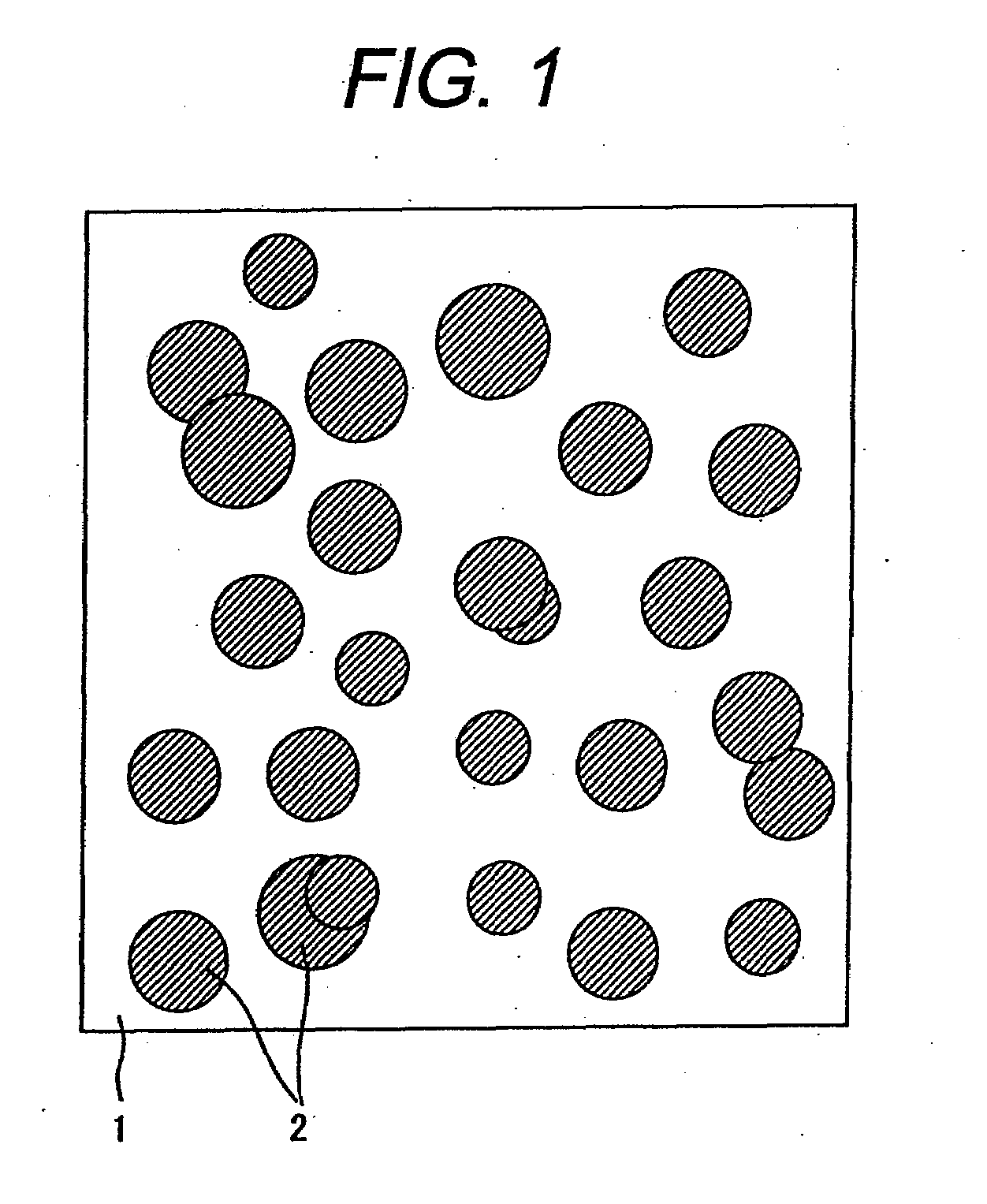Optical glass
a technology of optical glass and reflection rate, applied in the field of optical glass with a high reflection rate, can solve the problems of difficult to obtain high refraction rate glass, glass becomes milky or milky white, and is not suitable for optical lens use, so as to achieve high refraction rate, reduce the size of the lens, and maintain high transparency
- Summary
- Abstract
- Description
- Claims
- Application Information
AI Technical Summary
Benefits of technology
Problems solved by technology
Method used
Image
Examples
example 1
[0042]In Example 1 explained is a sol-gel method for manufacturing optical glass wherein titanium oxide crystal grains were dispersed in a matrix composed of silicon oxide and titanium oxide. In this example the optical glass was prepared by the sol-gel method.
[0043]As a silicon oxide raw material for silicon alkoxide used was ethoxide silicon (Si(OC2O5)4). As a silicon oxide raw material for silicon alkoxide used was silicon ethoxide (Si(OC2O5)4). There are other silicon alkoxides such as methoxide silicon, silicon normal propoxide, isopropoxide silicon, silicon normal butoxide, silicon isobutoxide, silicon secondary butoxide, silicon tertiary butoxide, etc. These compounds are used singly or in combinations.
[0044]As a titanium oxide raw material for titanium alkoxide used was normal butoxide titanium (Ti(OC4O9)4). As a raw material for titanium oxide, used was titanium normal butoxide (Ti(OC4H9)4). There are other compounds are titanium alkoxides such as titanium metoxide, titaniu...
example 2
[0066]Then, optical characteristics (transmittance, refraction rate, reflection rate, and decay coefficient) of the optical glass obtained in example 1 were evaluated.
[0067]At first, the bulk optical glass obtained in example 1 was machined into 1.0 mm thick, and both faces of the slice were polished into mirror face. A transmittance thereof was measured. A reflection rate was measured by polishing the measure face to an optical mirror; roughening the rear face with #400 polishing paper; and measuring refraction from the rear face. An absorption spectrophotometer (U-4200 manufactured by Hitachi, Ltd) was used to measure the refraction rate. A measure range of wavelength was 200 nm to 1600 nm. FIG. 2 shows the transmittance and FIG. 3 shows the refraction rate.
[0068]The transmittance in a visible wavelength range of 380 nm to 780 nm was 70 to 80%, which is sufficiently high even a loss by refraction is reduced. According to FIG. 3 showing reflection rate, the reflection rate was abou...
example 3
[0072]Next, changes of optical characteristics of the amorphous matrix glass with respect to the composition of silicon oxide-titanium oxide were investigated. Various amorphous matrixes were prepared by changing ratios of silicon oxide-titanium oxide without adding titanium oxide crystal grains. Methods of preparation were the same as in example 1, except addition of the crystal grains not added. Table 1 shows compositions (mol %) of matrix glass, refraction rate (nD) at sodium D line, decay coefficient (kD), Abbe's number (νD), transmittance (TD) and reflection rate (RD).
TABLE 1CompositionSpecimen(mol %)No.SiO2TiO2nDkDνDTDRDgelation110001.450.016892.93.5◯29551.500.015692.13.9◯383171.570.014990.24.9◯475251.610.014188.95.6◯569311.650.013687.96.0◯650501.760.013284.87.6◯739611.830.012583.08.5◯829711.890.012381.49.3◯927731.900.012281.19.5◯1020801.940.012180.010.0◯111882—————X (whitemilky)
[0073]The specimen Nos. 1-10 were homogeneous transparent gel. The specimen Nos. 1-11 exhibited tha...
PUM
| Property | Measurement | Unit |
|---|---|---|
| grain size | aaaaa | aaaaa |
| grain size | aaaaa | aaaaa |
| average grain size | aaaaa | aaaaa |
Abstract
Description
Claims
Application Information
 Login to View More
Login to View More - R&D
- Intellectual Property
- Life Sciences
- Materials
- Tech Scout
- Unparalleled Data Quality
- Higher Quality Content
- 60% Fewer Hallucinations
Browse by: Latest US Patents, China's latest patents, Technical Efficacy Thesaurus, Application Domain, Technology Topic, Popular Technical Reports.
© 2025 PatSnap. All rights reserved.Legal|Privacy policy|Modern Slavery Act Transparency Statement|Sitemap|About US| Contact US: help@patsnap.com



